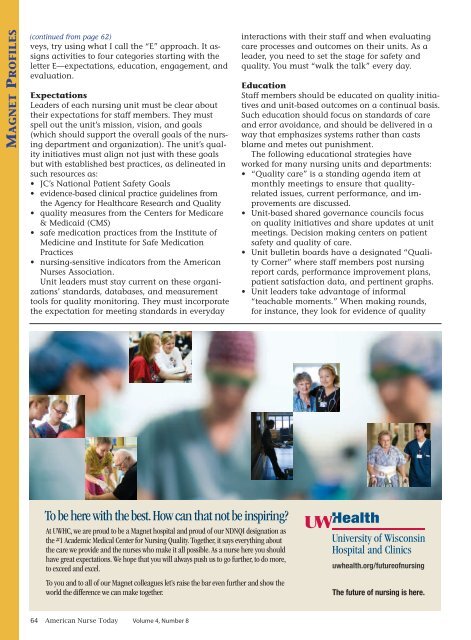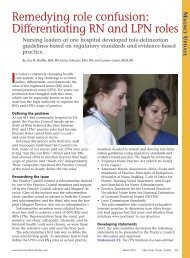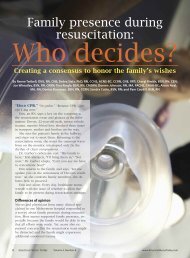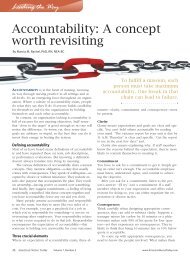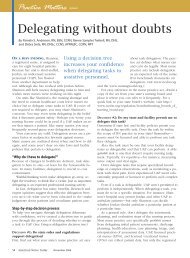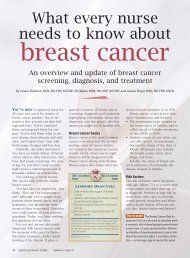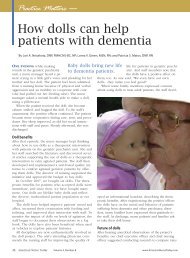2009 MAGNET™ PROFILES - American Nurse Today
2009 MAGNET™ PROFILES - American Nurse Today
2009 MAGNET™ PROFILES - American Nurse Today
You also want an ePaper? Increase the reach of your titles
YUMPU automatically turns print PDFs into web optimized ePapers that Google loves.
MAGNET <strong>PROFILES</strong><br />
(continued from page 62)<br />
veys, try using what I call the “E” approach. It assigns<br />
activities to four categories starting with the<br />
letter E—expectations, education, engagement, and<br />
evaluation.<br />
Expectations<br />
Leaders of each nursing unit must be clear about<br />
their expectations for staff members. They must<br />
spell out the unit’s mission, vision, and goals<br />
(which should support the overall goals of the nursing<br />
department and organization). The unit’s quality<br />
initiatives must align not just with these goals<br />
but with established best practices, as delineated in<br />
such resources as:<br />
• JC’s National Patient Safety Goals<br />
• evidence-based clinical practice guidelines from<br />
the Agency for Healthcare Research and Quality<br />
• quality measures from the Centers for Medicare<br />
& Medicaid (CMS)<br />
• safe medication practices from the Institute of<br />
Medicine and Institute for Safe Medication<br />
Practices<br />
• nursing-sensitive indicators from the <strong>American</strong><br />
<strong>Nurse</strong>s Association.<br />
Unit leaders must stay current on these organizations’<br />
standards, databases, and measurement<br />
tools for quality monitoring. They must incorporate<br />
the expectation for meeting standards in everyday<br />
interactions with their staff and when evaluating<br />
care processes and outcomes on their units. As a<br />
leader, you need to set the stage for safety and<br />
quality. You must “walk the talk” every day.<br />
Education<br />
Staff members should be educated on quality initiatives<br />
and unit-based outcomes on a continual basis.<br />
Such education should focus on standards of care<br />
and error avoidance, and should be delivered in a<br />
way that emphasizes systems rather than casts<br />
blame and metes out punishment.<br />
The following educational strategies have<br />
worked for many nursing units and departments:<br />
• “Quality care” is a standing agenda item at<br />
monthly meetings to ensure that qualityrelated<br />
issues, current performance, and improvements<br />
are discussed.<br />
• Unit-based shared governance councils focus<br />
on quality initiatives and share updates at unit<br />
meetings. Decision making centers on patient<br />
safety and quality of care.<br />
• Unit bulletin boards have a designated “Quality<br />
Corner” where staff members post nursing<br />
report cards, performance improvement plans,<br />
patient satisfaction data, and pertinent graphs.<br />
• Unit leaders take advantage of informal<br />
“teachable moments.” When making rounds,<br />
for instance, they look for evidence of quality<br />
To be here with the best.How can that not be inspiring?<br />
At UWHC, we are proud to be a Magnet hospital and proud of our NDNQI designation as<br />
the #1 Academic Medical Center for Nursing Quality. Together, it says everything about<br />
the care we provide and the nurses who make it all possible. As a nurse here you should<br />
have great expectations. We hope that you will always push us to go further, to do more,<br />
to exceed and excel.<br />
To you and to all of our Magnet colleagues let’s raise the bar even further and show the<br />
world the difference we can make together.<br />
uwhealth.org/futureofnursing<br />
The future of nursing is here.<br />
64 <strong>American</strong> <strong>Nurse</strong> <strong>Today</strong> Volume 4, Number 8


